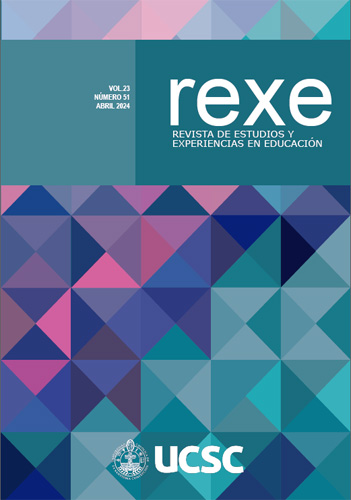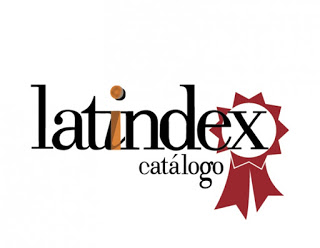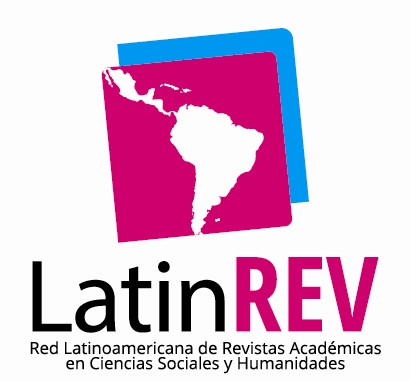Evaluation of Teacher Induction Programs (E-Tip): Validity of the Criteria
DOI:
https://doi.org/10.21703/rexe.v23i51.1706Palabras clave:
Education & Training, Educational Administration, Induction of Labor, Teacher Preparation, Job RotationResumen
The aim of this study was to validate the criteria of an instrument created to ensure the quality of teaching induction programs. It was an applied research with a mixed meth-od approach. The sample was non-probability by convenience. The instrument was constructed on the basis of available bibliography and the content was validated by expert judgment through a Likert scale with an alpha of Cronbach of 0.86. The Aiken V was applied to the judgment of the experts. The 14 relevant criteria had an average approval rate of 80.6% versus 3.6% of disapprovals and, according to the Aiken V, thirteen of the fourteen items should be included in the final version of the scale. In conclusion, the E-Tip criteria proved to be valid in the content validation. Furthermore, further research is needed on qualitative instruments to assess the criteria mentioned.
Descargas
Referencias
Allal-Chérif, O., Yela Aránega, A., & Castaño Sánchez, R. (2021). Intelligent recruitment: How to identify, select, and retain talents from around the world using artificial intelligence. Technological Forecasting and Social Change, 169. https://doi.org/10.1016/j.techfore.2021.120822 DOI: https://doi.org/10.1016/j.techfore.2021.120822
Al-Romeedy, B. Samir. (2019). The role of job rotation in enhancing employee performance in the Egyptian travel agents: the mediating role of organizational behavior. Tourism Review, 74, 1003–1020. https://www.emerald.com/insight/content/doi/10.1108/TR-10-2018-0153/full/html DOI: https://doi.org/10.1108/TR-10-2018-0153
Amushila, J., Bussin, M. H. R., & Bussin, M. (2021). SA Journal of Human Resource Management. https://doi.org/10.4102/sajhrm
Asamoah, D., Agyei-Owusu, B., & Ashun, E. (2020). Social network relationship, supply chain resilience and customer-oriented performance of small and medium enterprises in a developing economy. Benchmarking, 27(5), 1793–1813. https://doi.org/10.1108/BIJ-08-2019-0374 DOI: https://doi.org/10.1108/BIJ-08-2019-0374
Badrianto, Y., & Ekhsan, M. (2020). EFFECT OF WORK ENVIRONMENT AND JOB SATISFACTION ON EMPLOYEE PERFORMANCE IN PT. NESINAK INDUSTRIES. Journal of Business, Management, and Accounting, 2(1), 85–91. http://e-journal.stie-kusumanegara.ac.id
Bakker, T., Dugué, P., & de Tourdonnet, S. (2021). Assessing the effects of Farmer Field Schools on farmers’ trajectories of change in practices. Agronomy for Sustainable Development. https://doi.org/10.1007/s13593-021-00667-2/Published DOI: https://doi.org/10.1007/s13593-021-00667-2
Bencsik, A. (2021). The sixth generation of knowledge management – the headway of artificial intelligence. Journal of International Studies, 14(2), 84–101. https://doi.org/10.14254/2071-8330.2021/14-2/6 DOI: https://doi.org/10.14254/2071-8330.2021/14-2/6
Bermúdez Restrepo, H. L. (2011). La inducción general en la empresa. Entre un proceso administrativo y un fenómeno sociológico. Universidad & Empresa, 21, 117–142. http://www.redalyc.org/resumen.oa?id=187222420006
Bloom, N., Bunn, P., Mizen, P., Smietanka, P., & Thwaites, G. (2022). Staff Working Paper No. 900. The impact of Covid-19 on productivity. (No. 900; Staff Working Paper ). www.bankofengland.co.uk/working-paper/staff-working-papers
Böckerman, P., & Ilmakunnas, P. (2008). Interaction of working conditions, job satisfaction, and sickness absences: Evidence from a representative sample of employees. Social Science and Medicine, 67(4), 520–528. https://doi.org/10.1016/j.socscimed.2008.04.008 DOI: https://doi.org/10.1016/j.socscimed.2008.04.008
Boukis, A., & Christodoulides, G. (2020). Investigating Key Antecedents and Outcomes of Employee-based Brand Equity. European Management Review, 17(1), 41–55. https://doi.org/10.1111/emre.12327 DOI: https://doi.org/10.1111/emre.12327
Bozu, Z. (2009). El profesorado universitario novel y su proceso de inducción profesional. https://www.redalyc.org/pdf/2810/281021548008.pdf
Bretones, F. D., & González, J. M. (2009). Absentismo y rotación laboral. Psicología Del Trabajo, January 2009, 91–113. https://www.researchgate.net/publication/302167865_Absentismo_y_rotacion_laboral
Bureau of Labor Statistics, U. S. (2020). Department of Labor, Occupational Outlook Handbook, Postsecondary Teachers. https://www.bls.gov/ooh/education-training-and-library/postsecondary-teachers.htm#tab-4
Çakmak, M., Gündüz, M., & Emstad, A. B. (2019). Challenging moments of novice teachers: survival strategies developed through experiences. Cambridge Journal of Education, 49(2), 147–162. https://doi.org/10.1080/0305764X.2018.1476465 DOI: https://doi.org/10.1080/0305764X.2018.1476465
Cambridge Dictionary. (2022). Meaning of TEACHER. https://dictionary.cambridge.org/es/diccionario/ingles/teacher
Colmenárez, L. (2008). Proceso de Inducción del Personal Docente del Decanato de Administración y Contaduría de la UCLA. 11, 5–22. https://www.taylorfrancis.com/books/mono/10.4324/9781003223207/improvising-teacher-nick-sorensen
del Giudice, M., Scuotto, V., Papa, A., Tarba, S. Y., Bresciani, S., & Warkentin, M. (2021). A Self-Tuning Model for Smart Manufacturing SMEs: Effects on Digital Innovation. Journal of Product Innovation Management, 38(1), 68–89. https://doi.org/10.1111/jpim.12560 DOI: https://doi.org/10.1111/jpim.12560
Du, Y., & Liu, H. (2020). Analysis of the influence of psychological contract on employee safety behaviors against COVID-19. International Journal of Environmental Research and Public Health, 17(18), 1–14. https://doi.org/10.3390/ijerph17186747 DOI: https://doi.org/10.3390/ijerph17186747
Ellerbrock, C. R., Main, K. M., & Virtue, D. C. (2022). Middle Level Teacher Preparation across International Contexts: Understanding Local and Global Factors Influencing Teacher Education. https://doi.org/https://doi.org/10.4324/9781003213789 DOI: https://doi.org/10.4324/9781003213789
Fernández De Pelekais, C., el Kadi, O., & Financial, K. (2019). Happiness as a potential tool of productivity in financial organizations. Revista Global Neotium, 2(2), 99–112. https://www.researchgate.net/publication/335541185 DOI: https://doi.org/10.53485/rgn.v2i2.78
Flores Gómez, C. X. (2014). Inducción de profesores novatos en Chile: un estudio de caso. Pensamiento Educativo. Revista de Investigación Educacional Latinoamericana, 51(2), 41–55. https://doi.org/10.7764/PEL.51.2.2014.4 DOI: https://doi.org/10.7764/PEL.51.2.2014.4
Garay, L. (2010). Paradigmas en la Investigación Educativa. In MMINEDU Perú. http://www2.minedu.gob.pe/digesutp/formacioninicial/?p=411
González Brito, A. I., Araneda Garcés, N., Hernández González, J., & Lorca Tapia, J. (2005). Inducción Profesional Docente. Estudios Pedagógicos (Valdivia), 31(1). https://doi.org/10.4067/s0718-07052005000100003 DOI: https://doi.org/10.4067/S0718-07052005000100003
González Torres, A. (2019). Procedimiento de trabajo para facilitar el diseño de perfiles de cargos por competencias en la Universidad Central “Marta Abreu” de las Villas [Universidad Central “Marta Abreu” d elas Villas]. http://dspace.uclv.edu.cu:8089/handle/123456789/11283
Grados, J. (2013). Reclutamiento, selección, contratación e inducción del personal. https://www.academia.edu/34731979/Reclutamiento_selección_contratación_e_inducción_del_personal_Jaime_Grados
Hamurabi Sözen, P. (2018). CHALLENGES OF NOVICE TEACHERS. IJAEDU-International E-Journal of Advances in Education, IV(12). http://ijaedu.ocerintjournals.org/en/download/article-file/615408 DOI: https://doi.org/10.18768/ijaedu.478254
Hernández-Sampieri, R., & Mendoza Torres, C. P. (2018). Hernández-Sampieri, R. & Mendoza, C. (2018). Metodología de la Investigación. Las Rutas cuantitativas, cualitativa y mixta. Mc Graw Hill Education. https://doi.org/https://doi.org/10.22201/fesc.20072236e.2019.10.18.6 DOI: https://doi.org/10.22201/fesc.20072236e.2019.10.18.6
IGI Global. (2022). What is Teacher. https://www.igi-global.com/dictionary/family-community-higher-education-partnership/48939
Iwuanyanwu, P. N. (2022). Facilitating Problem Solving in a University Undergraduate Physics Classroom: The Case of Students’ Self-Efficacy. Interdisciplinary Journal of Environmental and Science Education, 18(2), e2270. https://doi.org/10.21601/ijese/11802 DOI: https://doi.org/10.21601/ijese/11802
Jai, T. M. (Catherine), Fang, D., Bao, F. S., James, R. N., Chen, T., & Cai, W. (2021). Seeing It Is Like Touching It: Unraveling the Effective Product Presentations on Online Apparel Purchase Decisions and Brain Activity (An fMRI Study). Journal of Interactive Marketing, 53, 66–79. https://doi.org/10.1016/j.intmar.2020.04.005 DOI: https://doi.org/10.1016/j.intmar.2020.04.005
Johnson, A., Galloway, C., Friedlander, E., & Goldenberg, C. (2019). Advancing educational quality in Rwanda: Improving teachers’ literacy pedagogy and print environments. International Journal of Educational Research, 98, 134–145. https://doi.org/10.1016/j.ijer.2019.08.016 DOI: https://doi.org/10.1016/j.ijer.2019.08.016
Koehler, A. A., & Kim, M. C. (2012). Improving Beginning Teacher Induction Programs through Distance Education. CONTEMPORARY EDUCATIONAL TECHNOLOGY, 2012(3), 212–233. https://doi.org/https://doi.org/10.30935/cedtech/6079 DOI: https://doi.org/10.30935/cedtech/6079
Kozikoglu, I. (2017). A content analysis concerning the studies on challenges faced by novice teachers. Cypriot Journal of Educational Sciences, 91–106. https://www.ceeol.com/search/article-detail?id=965396 DOI: https://doi.org/10.18844/cjes.v12i2.1278
Kraiger, K. (2022). Online I-O graduate education: Where are we and where should we go? Industrial and Organizational Psychology, 15(2), 151–171. https://doi.org/10.1017/iop.2021.144 DOI: https://doi.org/10.1017/iop.2021.144
Le, H. T. Q., & Nguyen, T. H. (2022). A study on Non-English Major Students’ Learner Autonomy: Difficulties and Solutions. International Journal of TESOL & Education, 2(3), 197–207. https://doi.org/10.54855/ijte.222313 DOI: https://doi.org/10.54855/ijte.222313
Leu, E. (2005). The Role of Teachers, Schools, and Communities in Quality Education: A Review of the Literature (1st ed.). Academy for Educational Development, Incorporated . https://files.eric.ed.gov/fulltext/ED490174.pdf
Levin, J. M., & Kleiner, B. H. (1992). How to reduce organizational turnover and absenteeism. https://doi.org/https://doi.org/10.1108/00438029210018633 DOI: https://doi.org/10.1108/00438029210018633
Macgregor, E., Hsieh, Y., & Kruchten, P. (2005). Cultural Patterns in Software Process Mishaps: Incidents in Global Projects. Workshop on Human and Social Factors of Software Engineering, 2–5. https://doi.org/doi:10.1145/1083106.1083116 DOI: https://doi.org/10.1145/1083106.1083116
Marcelo, C. (2009). Los comienzos de la docencia: un profesorado con buenos principios. 13, 1. https://recyt.fecyt.es/index.php/profesorado/article/view/41898
Marcelo, C., Mayor, C., & Murillo, P. (2009). MONOGRÁFICO: PROFESORADO PRINCIPIANTE E INSERCIÓN PROFESIONAL A LA DOCENCIA. Revista de Currículum y Formación Del Profesorado, 13(1), 1. https://revistaseug.ugr.es/index.php/profesorado/article/view/20568/20045
Marcelo García, C. (1999). Estudio sobre estrategias de inserción profesional en Europa. Revista Iberoamericana de Educación, 19, 1–33. https://rieoei.org/historico/oeivirt/rie19a03.htm DOI: https://doi.org/10.35362/rie1901056
Mejía Pérez, G. (2019). Un panorama del mercado laboral docente en la Educación Superior en México. Revista de Educación Superior En América Latina. https://doi.org/ttp://dx.doi.org/10.14482/esal.5.378.122 DOI: https://doi.org/10.14482/esal.5.378.122
Merriam-Webster. (2022). Teacher Definition & Meaning. https://www.merriam-webster.com/dictionary/teacher
Min, Y., Yexiang, F., Weilin, T., & Jiajie, Z. (2020). Study on safety behavior planning theory and control strategies for coal chemical workers. Safety Science, 128. https://doi.org/10.1016/j.ssci.2020.104726 DOI: https://doi.org/10.1016/j.ssci.2020.104726
Mlekus, L., & Maier, G. W. (2021). More Hype Than Substance? A Meta-Analysis on Job and Task Rotation. In Frontiers in Psychology (Vol. 12). Frontiers Media S.A. https://doi.org/10.3389/fpsyg.2021.633530 DOI: https://doi.org/10.3389/fpsyg.2021.633530
Mustafa, M. ;, Alzubi, F. K. ;, & Bashayreh, A. (2022). Factors Affecting Job Performance of Teaching and Non-Teaching Staff in Higher Education Levels in Oman. Privacy Policy A/B Testing Terms of Use Copyright Cookie Policy. In Source: Ilkogretim Online. 2021 (Vol. 20). https://www.bibliomed.org/mnsfulltext/218/218-1616506690.pdf?1709690543
Neuer Colburn, A. A., & Bowman, S. N. (2021). CES-SUCCESS: A Role Induction Group to Prepare Future Counselor Educators. Journal for Specialists in Group Work, 46(2), 202–213. https://doi.org/10.1080/01933922.2021.1900961 DOI: https://doi.org/10.1080/01933922.2021.1900961
OECD. (2021). Education at a Glance 2021. OECD. https://doi.org/10.1787/b35a14e5-en DOI: https://doi.org/10.1787/b35a14e5-en
Omanović, V., & Langley, A. (2021). Assimilation, Integration or Inclusion? A Dialectical Perspective on the Organizational Socialization of Migrants. Journal of Management Inquiry. https://doi.org/10.1177/10564926211063777 DOI: https://doi.org/10.1177/10564926211063777
Orozco Delgado, V. H. (2001). Reflexiones teórico-metodológicas para desarrollar el proceso de inducción como apoyo a la gestión del recurso humano universitario. Revista Educación, 25(1), 27. https://doi.org/10.15517/revedu.v25i1.2929 DOI: https://doi.org/10.15517/revedu.v25i1.2929
Otele, E. P. W. (2022). Influence of Induction Practices On Service Delivery by Newly Employed Teachers in Primary Schools [JARAMOGI OGINGA ODINGA UNIVERSITY OF SCIENCE AND TECHNOLOGY]. http://ir.jooust.ac.ke:8080/xmlui/handle/123456789/10974
Oxford Advanced Learner’s Dictionary. (2022). Definition of teacher. https://www.oxfordlearnersdictionaries.com/definition/english/teacher
Öztürk, M. (2008). INDUCTION INTO TEACHING: ADAPTATION CHALLENGES OF NOVICE TEACHERS [Graduate School of Social Sciences of Middle East Technical University]. https://open.metu.edu.tr/handle/11511/18265
Pazyura, N. (2015). Progressive ideas in updating teacher trainning in developed countries. Proceedings of the National Aviation University, 2(63), 120–123. https://doi.org/https://doi.org/10.18372/2306-1472.63.8879 DOI: https://doi.org/10.18372/2306-1472.63.8879
Pedraja-Rejas, L., & Rodríguez-Ponce, E. (2015). El aseguramiento de la calidad: un imperativo estratégico en la educación universitaria. Ingeniare. Revista Chilena de Ingeniería, 23(1), 4–5. https://doi.org/http://dx.doi.org/10.4067/S0718-33052015000100001 DOI: https://doi.org/10.4067/S0718-33052015000100001
Puji Astuti, J., Sa, N., Diah Rahmawati, S., Yuli Astuti, R., Sudargini, Y., & Stikubank Semarang, U. (2020). The Effect of Work Motivation, Work Environment, Work Discipline on Employee Satisfaction and Public Health Center Performance. JOURNAL INDUSTRIAL ENGINEERING & MANAGEMENT RESEARCH ( JIEMAR), 1(2), 2722–8878. https://doi.org/10.7777/jiemar.v1i2
Qian, S. (2022). Reform and Innovation of Higher Education in Economic Reform Period. International Journal of Education and Humanities, 2(3). https://drpress.org/ojs/index.php/ijeh/article/view/382/320 DOI: https://doi.org/10.54097/ijeh.v2i3.382
Rewel Jiminez, S. J., Thi Anh, D., Ehsan Ullah, S., & Sadiq, M. (2021). Development of Human Resource Management Activities in Vietnamese Private Companies. In Turkish Journal of Computer and Mathematics Education (Vol. 12, Issue 14). https://www.researchgate.net/publication/355384107_Development_of_Human_Resource_Management_Activities_in_Vietnamese_Private_Companies
Reynoso Castillo, C. (2007). Notas sobre la Capacitación en México. 5, 165–190. https://www.redalyc.org/pdf/4296/429640260009.pdf DOI: https://doi.org/10.22201/iij.24487899e.2007.5.9519
Rodríguez, D. (2006). Gestión Organizacional (4th ed.). https://www.academia.edu/43370463/Gestion_Organizacional_Dario_Rodriguez
Rodríguez, D. (2013). Diagnóstico Organizacional. https://tecnoadministracionpub.files.wordpress.com/2019/08/libro_diagnostico_organizacional_dario_r.pdf
Rodríguez Mansilla, D., & Quezada Menares, S. (2007). Cultura en las Organizaciones del Tercer Sector. Revista Española Del Tercer Sector, 121–152. https://dialnet.unirioja.es/servlet/articulo?codigo=2376738
Rodriguez Vite, H. (2017). Importancia de la formación de los docentes en las instituciones educativas. Ciencia Huasteca Boletín Científico de La Escuela Superior de Huejutla, 5(9). https://doi.org/https://doi.org/10.29057/esh.v5i9.2219 DOI: https://doi.org/10.29057/esh.v5i9.2219
Rostini, D., Zaeni, R., Syam, A., & Achmad, W. (2022). The Significance of Principal Management on Teacher Performance and Quality of Learning. Jurnal Pendidikan, 14(2), 2513–2520. https://doi.org/10.35445/alishlah.v14i1.1721 DOI: https://doi.org/10.35445/alishlah.v14i2.1721
Ruffinelli Vargas, A. (2016). Ley de desarrollo profesional docente en Chile: de la precarización sistematica a los logros, avances y desafíos pendientes para la profesionalización. Estudios Pedagógicos, XLII(4), 261–279. https://doi.org/http://dx.doi.org/10.4067/S0718-07052016000500015 DOI: https://doi.org/10.4067/S0718-07052016000500015
Rymaniak, J., Lis, K., Davidavičienė, V., Pérez-Pérez, M., & Martínez-Sánchez, Á. (2021). From stationary to remote: Employee risks at pandemic migration of workplaces. Sustainability (Switzerland), 13(13). https://doi.org/10.3390/su13137180 DOI: https://doi.org/10.3390/su13137180
Salgado-Cruz, M., Gómez-Figueroa, O., & Juan-Carvajal, D. (2017). Niveles para la capacitación en una organización. Ingeniería Industrial, 38(2), 154–160. https://www.redalyc.org/pdf/3604/360452099004.pdf
Salokhojaeva, F. (2022). Methodology for the Development of Communicative Competence Through Steam Technologies. International Journal of Social Science Research and Review, 5(2), 111–116. https://doi.org/10.47814/ijssrr.v5i2.207 DOI: https://doi.org/10.47814/ijssrr.v5i2.207
Santiago Páez, M. (2019). Optimización del proceso pedagógico y la gestión docente: una mirada a los entornos virtuales de aprendizaje. https://doi.org/10.13140/RG.2.2.35697.63845
Segovia Gutierrez, E. (2020). Plan de acción en el área de talento humano para procesos de inducción y desarrollo del personal de la empresa Image S.A. http://repositorio.ucsg.edu.ec/handle/3317/14479
Shibru, B. (2022). Impact of Employee Turnover on Organizational Performance: The Case of Bekas Chemicals Plc., Ethiopia. Journal of Material Sciences & Manufacturing Research. https://doi.org/10.47363/JMSMR/2022(3)125 DOI: https://doi.org/10.47363/JMSMR/2022(3)125
Shipman, K., Burrel, D. N., & mac Pherson, A. H. (2021). An organizational analysis of how managers must understand the mental health impact of teleworking during COVID-19 on employees. International Journal of Organizational Analysis. https://doi.org/https://doi.org/10.1108/IJOA-03-2021-2685 DOI: https://doi.org/10.1108/IJOA-03-2021-2685
Sisto, V. (2011). New professionalism and teachers: a reflection from the analysis of current policies of “professionalism” for education in Chile. Signo y Pensamiento, XXXI(59), 178–192. http://www.scielo.org.co/scielo.php?script=sci_arttext&pid=S0120-48232011000200013
Sood, H., & Ong, C. E. (2022). Revisiting Job Rotation and Stress. In The Complexities and Strategies of Occupational Stress (pp. 300–322). https://doi.org/10.4018/978-1-6684-3937-1.ch017 DOI: https://doi.org/10.4018/978-1-6684-3937-1.ch017
Sorensen, N. (2022). The improvising teacher : reconceptualising pedagogy, expertise and professionalism (Routledge, Ed.). Taylor & Francis. https://doi.org/https://doi.org/10.4324/9781003223207 DOI: https://doi.org/10.4324/9781003223207
Strom, K. J., & Viesca, K. M. (2021). Towards a complex framework of teacher learning-practice. Professional Development in Education, 47(2–3), 209–224. https://doi.org/10.1080/19415257.2020.1827449 DOI: https://doi.org/10.1080/19415257.2020.1827449
The National Institute of Occupational Safety and Health. (2020). Quality of Worklife Questionnaire | NIOSH | CDC. Stress at Work. https://www.cdc.gov/niosh/topics/stress/qwlquest.html#download
Thomson, G. (2021). The Global Report on the Status of Teachers 2021. https://www.ei-ie.org/en/item/25403:the-global-report-on-the-status-of-teachers-2021
United Nations. (2020). Development program. Goal 4. Quality education. https://www.un.org/sustainabledevelopment/education/
University of Leeds. (2022). What is a Professor? : Professors and professorship: origins and history. https://professors.leeds.ac.uk/what-is-a-professor/
Velando Rodríguez, M. (2004). El proceso de abandono voluntario: revisión de las principales aportaciones realizadas en la literatura. Investigaciones Europeas de Dirección y Economía de La Empresa, 10(3), 157–169. https://dialnet.unirioja.es/servlet/articulo?codigo=1096696
Waychunas, W. (2022). Context and the Continuum: Insights and Connections Between Preparation, School Organization, and Beginning Teachers’ Instruction (pp. 338–358). https://doi.org/10.4018/978-1-6684-3848-0.ch017 DOI: https://doi.org/10.4018/978-1-6684-3848-0.ch017
Wendel, M. (2022). TEACHER PERCEPTIONS OF THE SUPPORTS AND BARRIERS FOR PROFESSIONAL COLLABORATION: A PHENOMENOLOGICAL STUDY [Middle Tennessee State University]. https://media.proquest.com/media/hms/PFT/2/iJ3oM?_s=NHJNF%2BzP%2BQmqw7P1dNObVa1LSR8%3D
Willis, U. M. (2022). Improving the beginning teacher induction program experience for African-American teachers within the green pastures school district: an applied study [Liberty University]. https://digitalcommons.liberty.edu/cgi/viewcontent.cgi?article=4656&context=doctoral
Yoon, I., & Kim, M. (2022). Dynamic patterns of teachers’ professional development participation and their relations with socio-demographic characteristics, teacher self-efficacy, and job satisfaction. Teaching and Teacher Education, 109(103565). https://doi.org/10.1016/j.tate.2021.103565 DOI: https://doi.org/10.1016/j.tate.2021.103565
Yurkofsky, M. (2022). From Compliance to Improvement: How School Leaders Make Sense of Institutional and Technical Demands When Implementing a Continuous Improvement Process. Educational Administration Quarterly, 58(2), 300–346. https://doi.org/10.1177/0013161X211053597 DOI: https://doi.org/10.1177/0013161X211053597
Descargas
Publicado
Número
Sección
Licencia
Derechos de autor 2023 María Mercedes Yeomans Cabrera, Jonathan Martínez-Líbano

Esta obra está bajo una licencia internacional Creative Commons Atribución 4.0.
Política de acceso abierto
Esta revista proporciona un acceso abierto inmediato a su contenido, basado en el principio de que ofrecer al público un acceso libre a las investigaciones ayuda a un mayor intercambio global de conocimiento.
Licencia
Revista REXE "Revista de Estudios y Experiencias en Educación" de la Facultad de Educación, Universidad Católica de la Santísima Concepción, está distribuido bajo una Licencia Creative Commons Atribución 4.0 Internacional.






